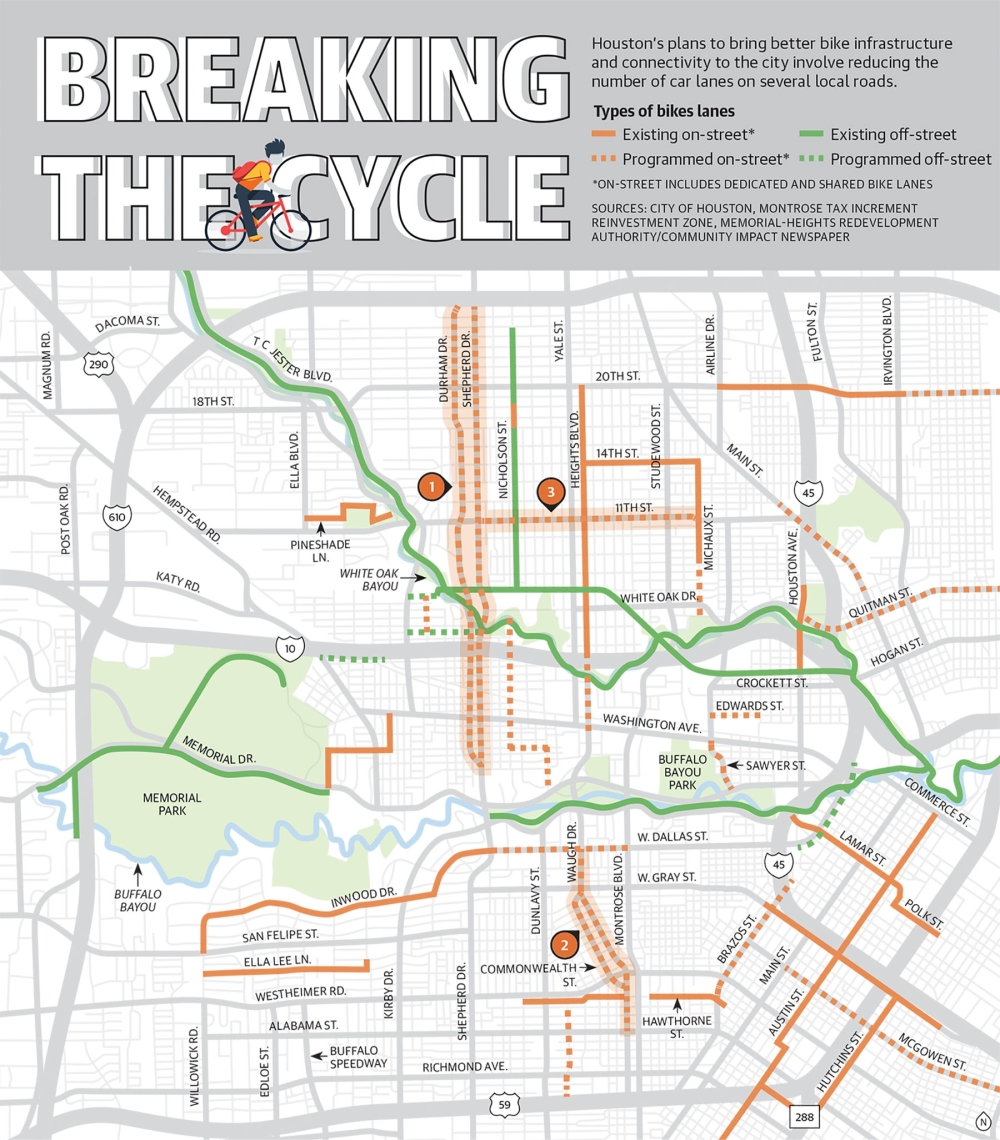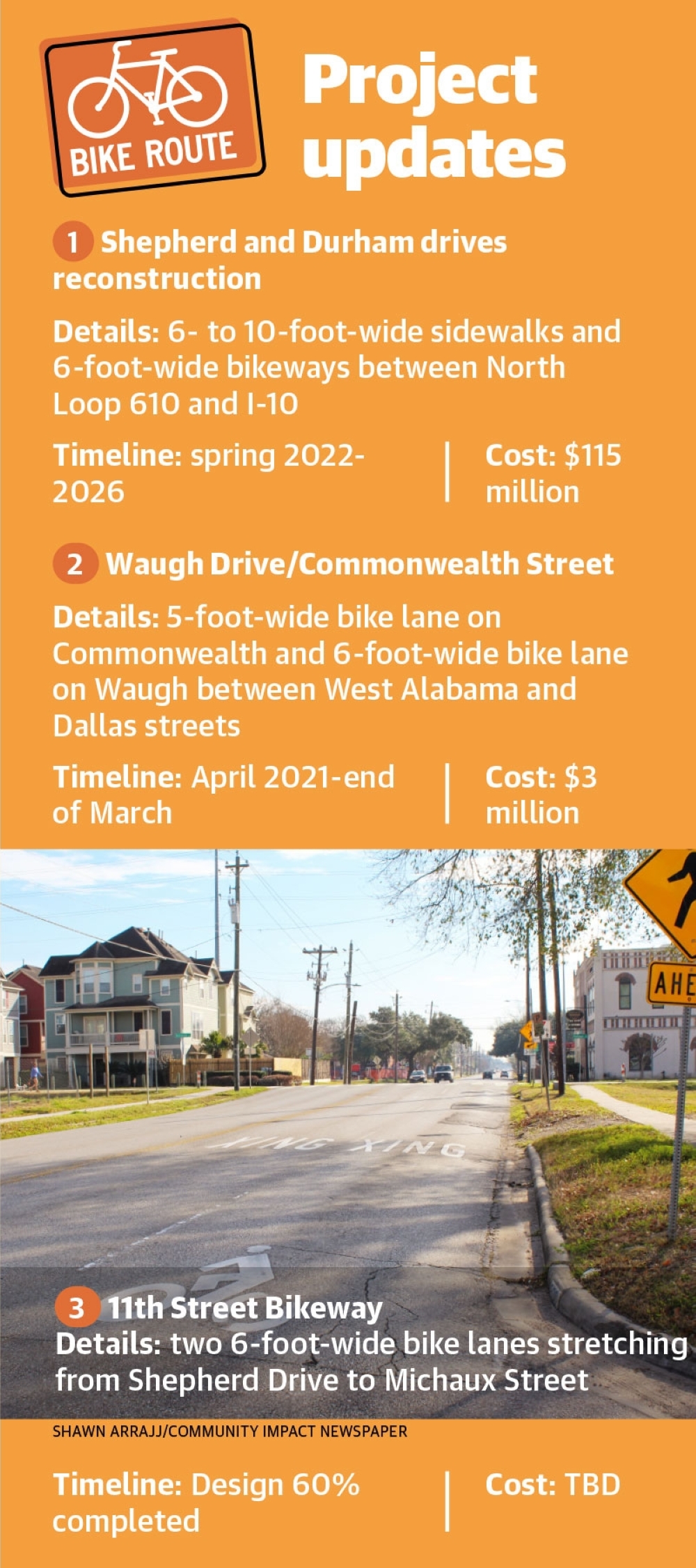“Everything you hear about Houston is how it’s a sprawl city where there is no bicycle and pedestrian planning, and it’s terrible for bikers,” she said.
But Raschke, said she thinks the city has come a long way since then. As a transportation planner with planning and engineering firm The Goodman Corporation, she has both witnessed and been involved in several bike projects since Houston adopted the Houston Bike Plan in 2017, which looks to connect neighborhoods with existing trails and other destination points.
Five years after adopting the plan, several high-profile projects are coming to life, including in the Heights and Montrose areas. Work will begin this spring on a reconstruction of Shepherd and Durham drives that will bring bike lanes and wider sidewalks from North Loop 610 to I-10, and designs are underway on the 11th Street Bikeway through the heart of the Heights.
Upgrading the bike infrastructure on those streets will involve either narrowing the width of car lanes or reducing the number of them, a method referred to by transportation planners as a “road diet.” Doing so represents both a commitment to safety and to making roads usable for all types of travelers, said David Fields, chief transportation planner with the city of Houston.
“We will not design something that is not safe for all ages and abilities for bike riders anymore,” he said. “Some of our early projects from a long time ago are not designs we would build today.”
Fixing a reputation
Houston’s bike plan calls for almost 1,800 miles of new high-comfort bike lanes—or lanes that are safe for all ages—throughout the city, Fields said.
Because of how large of an undertaking the plan is, Fields said city staff does not have an end date for when all projects would be completed. Instead, city planners revisit the plan every few years to determine which projects should be prioritized based on safety, demand, equity and connectivity.
Joe Cutrufo, the executive director of cyclist advocacy group BikeHouston, said he thinks the city has a lot of work to do to make Houston a more bike-friendly city, but he said the amount of work already underway is more than meets the eye.
“The bike network that exists today is kind of like a tree that you can see, but you can’t see all the roots underground,” he said. “We have all these roots that you can’t see because there’s so much in planning.”

Local projects and safety
The 11th Street Bikeway is one of eight bike projects in the design phase as a part of the Houston Bike Plan as of February. While the city has taken the lead on that project, others in the Heights and Montrose areas are accelerating with the help of local tax increment reinvestment zones and redevelopment authorities—municipal organizations funded by property tax revenue that work with Houston to bring improvements to an area.
Proposed plans on 11th Street involve shrinking the number of car lanes from four lanes to two with bike lanes added on each side. The project includes two 6-foot-wide bike lanes stretching from Shepherd Drive to Michaux Street and going down to White Oak Bayou. Design work could be completed this spring.
Some portions of the streets affected by the road diet will go down to three lanes to implement a safe center turn lane, said Lauren Grove, a project manager with the Houston Public Works Department.
Fields said road diets, when implemented properly, will not have the negative effect on the traffic that some might think. When looking at 11th Street, Houston planners found one lane in each direction could accommodate traffic with the exception of about 45 minutes on weekdays, he said.
Not only is the unused space a bad use of the city’s right of way, Fields said it also contributes to a speeding problem on 11th Street, where the average speed is 38.5 mph despite the speed limit being 30 mph.
“Drivers drive faster when there is more space that is not being filled up,” he said.
For the $115 million Shepherd and Durham project, lanes will decrease from four to three, according to Sherry Weesner, president of the Memorial-Heights Redevelopment Authority, which is carrying out and funding the project. Once completed, there will be improved turn lanes and drainage, 6- to 10-foot-wide sidewalks for pedestrians and 6-foot-wide bikeways.
Two separate studies—one by the redevelopment authority and one by the city of Houston—found the project would improve traffic flow despite the road diet, Weesner said, because it also involves the strategic implementation of turning lanes.
“This is one of those rare but wonderful places in Houston where redoing the road ... improves traffic throughput, improves bike facilities, improves pedestrian facilities and improves the transit on the street,” she said.

Building momentum
When Houston planners met last fall to determine what bike projects should be taken up next, they landed on three, Fields said: the Irvington Boulevard corridor from downtown to outside of Loop 610; a bike network in the Gulfton area; and the Washington Avenue corridor.
Infrastructure on Washington Avenue—where an H-E-B recently opened—has not kept up with land uses, Fields said.
“It’s not a place we think people should be driving fast to get through, or to get out,” he said. “It’s really a place we think people want to get to, instead.”
Now that it has been identified as a priority project, Fields said the city is working with the Houston-Galveston Area Council, which has agreed to pay for consulting work that is expected to begin this summer.
The H-GAC also played a role in bringing the Shepherd/Durham project to life, providing $40 million for the project's second phase. Susan Jaworski, a senior transportation planner with the H-GAC, said federal funding available for "transportation alternative" projects—which includes projects with bike and pedestrian elements—has bee increasing as officials learn more about their benefits, including their ability to take cars off the road.
"It's kind of a chicken and egg thing," she said. "There's definitely been an increase in demand, and the funding has followed suit to encourage and support that."
The 11th Street Bikeway has garnered supporters, but some residents have decried the reduction in car lanes, saying it could lead to more cars going down small neighborhood streets to avoid traffic. Some business owners on 11th Street also said they had safety concerns.
“I’m concerned with traffic flow, especially during busy seasons when there’s specifically extra traffic around our business,” said Zach Buchanan, chief operating officer of Buchanan’s Native Plants, who emphasized that he is not against the proposed plan. “I think that what’s concerning is that there are so many unknowns, and it’s all just speculation as to what will actually be the end result.”
The city’s population growth has left it little choice when it comes to being smarter about roadway planning, Raschke said.
“The bigger you get, you start getting into the problem of traffic congestion getting worse and worse,” she said. “At some point, you don’t have enough space to widen the road without taking buildings away.”
Although Raschke said Houston will always be an auto-centric city, bike lanes can bring a sense of community to an area, a sentiment Cutrufo said he agreed with.
Cutrufo recalled a recent walk he went on with his children through Montrose, during which he discovered the record shop Soundwaves for the first time. Experiences like that, Cutrufo said, are much less likely while driving.
“When you’re traveling by bike, you’re taking in the world at a much slower pace,” he said. “You’re more likely to take in and notice the fine-grained nature of a city.”
Moving forward, Cutrufo said BikeHouston is pressing on the city to stay focused not only on building new bike lanes, but maintaining those that already exist. The city of Houston currently does not have a line item in its budget for bike lane maintenance, Cutrufo said, but he said he has had some encouraging conversations that one could be added to the budget this year.
Meanwhile, Fields said evidence is growing that, as the city builds better bike paths, more people ditch their cars where the option is available.
“Any time we put out a safe, protected bike facility, one people are comfortable using ... they get used very well,” Fields said.






